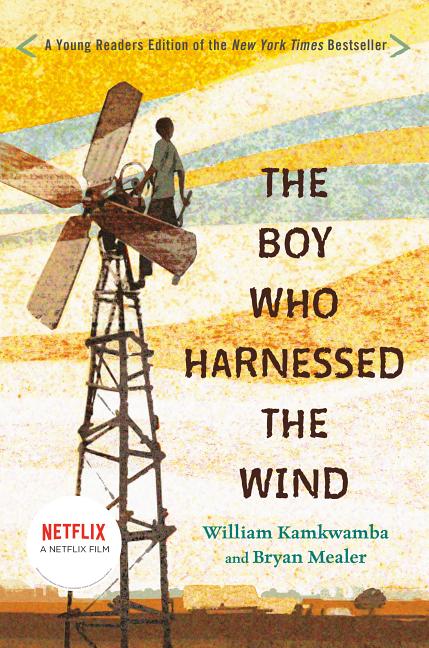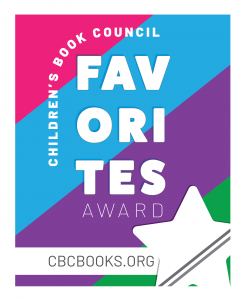
Book Resume
for The Boy Who Harnessed the Wind (Young Readers Edition) by William Kamkwamba, Bryan Mealer, and Anna Hymas
Professional book information and credentials for The Boy Who Harnessed the Wind (Young Readers Edition).
11 Professional Reviews (3 Starred)
3 Book Awards
Selected for 8 State/Province Lists
See full Book Resume
on TeachingBooks
After the devastating drought of 2000–2001 in Malawi, William Kamkwamba’s ...read more
- Booklist:
- Grades 5 - 8
- Kirkus:
- Ages 11 - 16
- School Library Journal:
- Grades 4 - 7
- Booklist:
- Grades 1 - 3
- School Library Journal:
- K - Grade 3
- Publisher's Weekly:
- Ages 6 - 8
- Kirkus:
- Ages 7 - 9
- TeachingBooks:*
- Grades 3-12
- Word Count:
- 58,297
- Lexile Level:
- 860L
- ATOS Reading Level:
- 5.8
- Cultural Experience:
- African
- Genre:
- Biography
- Nonfiction
- Year Published:
- 2015
17 Subject Headings
The following 17 subject headings were determined by the U.S. Library of Congress and the Book Industry Study Group (BISAC) to reveal themes from the content of this book (The Boy Who Harnessed the Wind (Young Readers Edition)).
- Mechanical engineers--Malawi--Biography--Juvenile literature
- Kamkwamba, William
- Mechanical engineers
- Inventors
- Malawi
- Irrigation
- Juvenile Nonfiction | Technology | Electricity & Electronics
- Electric power production--Malawi--Juvenile literature
- Kamkwamba, William, 1987---Juvenile literature
- Irrigation--Malawi--Juvenile literature
- Electric power production
- Juvenile Nonfiction | People & Places | Africa
- Windmills--Malawi--Juvenile literature
- Windmills
- Juvenile Nonfiction | Biography & Autobiography | Science & Technology
- Young Adult Fiction
- Inventors--Malawi--Biography--Juvenile literature
11 Full Professional Reviews (3 Starred)
The following unabridged reviews are made available under license from their respective rights holders and publishers. Reviews may be used for educational purposes consistent with the fair use doctrine in your jurisdiction, and may not be reproduced or repurposed without permission from the rights holders.
Note: This section may include reviews for related titles (e.g., same author, series, or related edition).
From Cooperative Children's Book Center (CCBC)
After the devastating drought of 2000–2001 in Malawi, William Kamkwamba’s family could no longer afford his school fees, but he continued to use the primary school library in his village. Interested in science, William found two books that inspired him to build his first windmill, which he used to power a small lightbulb at home. He went on to build a bigger windmill and wire his entire house, gaining attention that led to further educational opportunities. William scavenged everything, and not only had to understand the science but also think creatively. In this adaptation for young adults of William’s adult memoir, his voice is engaging and occasionally self-deprecating as he describes a confidence born of enthusiasm that kept him focused even when he faced ridicule, since early on no one understood what he was doing. It also kept him going through failure—an inevitable aspect of his experimentation. The context of William’s life—his community and family and the impact of the drought on his country—is as vivid as William’s optimism in this account that includes inset color photographs, including one of his recent graduation from Dartmouth. (Age 12 and older)
CCBC Choices 2016 © Cooperative Children's Book Center, Univ. of Wisconsin - Madison, 2016. Used with permission.
From Horn Book
January 1, 2015
As a young boy growing up in Malawi, William Kamkwamba believed in -- and was fearful of -- magic. As he got a bit older, he was drawn to science. He tinkered with toy trucks and "monster wagons" ("chigiriri, that looked like American go-carts") and began reading old science books and dreaming up inventions. When heavy rains, followed by drought, hit his country and the corrupt government didn't respond, young William used his scientific ingenuity to help people in need. He began making a windmill out of "bottle-cap washers, rusted tractor parts, and [an] old bicycle frame," and, to the amazement of family and community, it was a success. Soon he dreamed of conquering darkness, pumping water to the villages, and fighting hunger. This young readers' edition of the bestselling adult memoir The Boy Who Harnessed the Wind: Creating Currents of Electricity and Hope (already adapted as a picture book by the same name) has been simplified for a middle-grade audience, unfortunately losing some of the lyricism of the original. (Chapter one in the adult version opens, "Before I discovered the miracles of science, magic ruled the world." Chapter one here begins, "My name is William Kamkwamba, and to understand the story I'm about to tell, you must first understand the country that raised me.") Both versions have a straightforward narrative arc: because of the book's prologue, readers know that William's wind machine will be successful and that they, the readers, are to be inspired. And it is inspiring -- a well-told true tale of one young man's passion for science making his world better. dean schneider
(Copyright 2015 by The Horn Book, Incorporated, Boston. All rights reserved.)
From Booklist
December 15, 2014
Grades 5-8 By now, Kamkwamba's story about his ingenious windmill is well-knownhis 2009 memoir was a New York Times best-sellerand this young reader's edition of that memoir brings his story to a middle-grade audience. It's a good fit, especially since, at 14, Kamkwamba was not much older than his target age group when he set out to build electric wind. After a devastating famine kept him out of school, he taught himself electrical engineering, andequipped with insatiable curiosity and ample brainsKamkwamba succeeded in building a windmill out of junk and found materials to electrify his home. Though some of the descriptions of the electrical components might go over the heads of most middle-grade readers, his inspirational story about determination and a deep love for science will nonetheless strike a chord with aspiring inventors, and the stark descriptions of famine-stricken Malawi will open young readers' eyes to the hard realities of life in a Third World country. Many kids will find a kindred spirit in Kamkwamba.(Reprinted with permission of Booklist, copyright 2014, American Library Association.)
From Kirkus
Starred review from November 15, 2014
The author and his collaborator have condensed the original memoir of the same name, a story of an innovative and compassionate boy coming of age during an era of extreme hardship in Malawi.This newest incarnation of Kamkwamba's tale is as absorbing as its predecessor and still delivers with equanimity facts both disturbing and inspiring. Kamkwamba describes his early life in Masitala, a tiny rural village where, typically, large families of subsistence farmers lived in huts without electricity or running water. Until December 2000, Kamkwamba's life reads like an African parallel to the idyllic, early-20th-century scenes in Sterling North's Rascal: soccer with balls made from plastic bags; juicy mangoes and crunchy grasshoppers; storytelling by the light of a kerosene lamp; experiments with old radio parts; loyal friends and faithful pet. A perfect storm of deforestation, governmental changes, flooding and drought creates a sudden famine. The text does not spare readers the effects of starvation and grinding poverty on humans and animals. However, there are also many descriptions of how and why power-generating inventions work, and the passages about creating tools from almost nothing are reminiscent of Laura Ingalls Wilder's Little House series. Against astounding odds, Kamkwamba's eventual creation of a windmill to bring lighting to his family's home is nothing short of amazing. Compelling and informative for a broad readership and a good addition to STEM collections. (map, prologue, photographs, epilogue, acknowledgments) (Memoir. 11-16)
COPYRIGHT(2014) Kirkus Reviews, ALL RIGHTS RESERVED.
From School Library Journal
Starred review from November 1, 2014
Gr 4-7-This youth edition of the original adult book of the same title has been skillfully adapted for middle grade readers. Kamkwamba recounts a period from his childhood living in a small Malawi village. His family was poor, but they got by working as farmers. Kamkwamba was in elementary school, about to graduate to secondary school, when the drought and famine of the mid-2000s upset the patterns of local life. The author deftly describes the devastating effects upon his family: they ate insects, and rations were reduced to only a single mouthful daily. Many around them suffered even worse. Somehow, the family struggled through until the rains returned to nourish a new crop, but they couldn't afford Kamkwamba's school fees. He farmed with his father but also discovered a local library, where he taught himself to engineer a windmill to draw water to irrigate the fields. Those around him thought he was crazy as he salvaged motor parts, a PVC pipe, his father's broken bicycle, and anything else he could find. Kamkwamba did successfully harness the wind, managing to light his family's house, charge community cell phones for a small income, and pump irrigation water. A school inspection team saw the windmill and brought educators to see the teen engineer, who was invited to speak at the African TED conference and given a scholarship. This is a fascinating, well-told account that will intrigue curious minds, even the somewhat anticlimactic closing chapters describing Kamkwamba's education. There is also a picture book version of this tale (Dial, 2012), making it of interest to all-school reading programs. An inspiring, incredible story.-Dorcas Hand, Annunciation Orthodox School, Houston, TX
Copyright 2014 School Library Journal, LLC Used with permission.
From Horn Book
July 1, 2012
This junior version of the best-seller for adults describes how fourteen-year-old William Kamkwamba saves his drought-blighted Malawi village: after teaching himself English and reading science books at a library donated by "the Americans," he creates a windmill from odd parts. It's an amazing, emboldening story honored by the handsome oil paint and cut-paper illustrations, which call to mind quilts.
(Copyright 2012 by The Horn Book, Incorporated, Boston. All rights reserved.)
From Booklist
February 15, 2012
Grades 1-3 In his drought-stricken village in Malawi, Kamkwamba, 14, had to drop out of school, but he read about windmills in the library, and with scraps from the trashincluding a tractor fan, a shock absorber, the frame of a broken bicycle, rusted bottle caps, and plastic pipeshe buildt a windmill tower that brought electricity to his village. Based on the adult best-selling version of a true story, this picture book in accessible free verse will draw kids who love to construct their own engineering gadgets. Especially appealing is the triumph of the young boy who bottled, banged, and tinkered and saved his grown-up world. Zunon's double-page artwork, a blend of oil paintings and cut paper, shows the drought-stricken countryside and then the trash pieces the boy collects and recycles into a machine that makes energy for his community. The long afterword fills in more about the severe drought that brought famine and killed more than 10,000 people and about Kamkwamba's engineering studies now.(Reprinted with permission of Booklist, copyright 2012, American Library Association.)
From School Library Journal
January 1, 2012
K-Gr 3-Based on the best seller of the same title, this picture-book biography chronicles Kamkwamba's teen years in a Malawian village. As he tills the soil, his mind teems with a mix of mechanical questions and the magical stories relayed by his elders. When a drought destroys the crops, his education fund dries up as well. Kamkwamba seeks refuge in the American-built library, where, dictionary in hand, he decodes the function of a windmill that has captured his interest. Despite the murmurings of incredulous villagers, the young man assembles junkyard scraps to build "electric wind." The third-person descriptions and dialogue are flavored with African phrases. Zunon's compositions, rendered in cut paper and oils, create a variety of moods. Colorfully garbed ghost dancers populate the boy's dreams, while crumpled tan rice paper, arranged to depict a high horizon line just beneath a blazing sun, forms a parched landscape, overwhelming in scale. Swirls of patterned blue and green paper portray the wind that propels the blades of his creation. While an extensive author's note explains that it took several years to achieve the ability to irrigate, the lack of clear visuals to show how wind becomes electricity (and ultimately pumps water) may frustrate young children. That caveat aside, this is a dynamic portrait of a young person whose connection to the land, concern for his community, and drive to solve problems offer an inspiring model. It would pair well with one of the recent titles about Wangari Maathai.-Wendy Lukehart, Washington DC Public Library
Copyright 2012 School Library Journal, LLC Used with permission.
From Publisher's Weekly
December 5, 2011
Zunon's (My Hands Sing the Blues) oil paint and cut-paper collages amplify the entwined themes of science and magic in this adaptation of the authors' 2009 adult book. Kamkwamba was born in Malawi in 1987, and when he was 14, drought was ravaging his country. Forced to leave school to save money, Kamkwamba studied science books at the library, learning about windmills-and their potential. "He closed his eyes and saw a windmill outside his home, pulling electricity from the breeze and bringing light to the dark valley." Gathering materials from the junkyard, he assembles a windmill that creates "electric wind" and even lights a light bulb. Tradition and "tales of magic" combine with the promise of technology in this inspiring story of curiosity and ingenuity. Zunon's artwork combines naturalistic and more whimsical elements; the African sun beats down on Zunon's villagers, ribbony "ghost dancers" encircle Kamkwamba's bed while he sleeps, and blue cut-paper swirls sweep toward the windmill. While the narrative simplifies Kamkwamba's creative process, an afterword provides additional detail for readers who share his mechanical inclinations. Ages 6â€"8. Agent: ICM. Illustrator's agent: Painted Words.
From Kirkus
December 1, 2011
The true story of a Malawian teenager who leveraged need and library research into a windmill constructed from found materials. Forced by drought and famine to drop out of school, William dreams of "building things and taking them apart." Inspired by science books in an American-built library near his village, his dreams turn to creating "electric wind." Despite the doubts of others he begins--assembling discarded bicycle parts and other junk into a rickety tower, triumphantly powering an electric light and going on to dream of windmill-driven wells to water the land. Kamkwamba tells this version (another, for adult readers, was published with the same title in 2009) of his tale of inspiration meeting perspiration in terse, stately third person: "He closed his eyes and saw a windmill outside his home, pulling electricity from the breeze and bringing light to the dark valley." Zunon illustrates it handsomely, with contrasting cut-paper-collage details arranged on brown figures, and broad, sere landscapes painted in visibly textured oils. A plainspoken but inspiring tale of homespun ingenuity. (afterword) (Picture book/biography. 7-9)
(COPYRIGHT (2011) KIRKUS REVIEWS/NIELSEN BUSINESS MEDIA, INC. ALL RIGHTS RESERVED.)
From Publisher's Weekly
Starred review from September 29, 2009
American readers will have their imaginations challenged by 14-year-old Kamkwamba's description of life in Malawi, a famine-stricken, land-locked nation in southern Africa: math is taught in school with the aid of bottle tops ("three Coca-Cola plus ten Carlsberg equal thirteen"), people are slaughtered by enemy warriors "disguised... as green grass" and a ferocious black rhino; and everyday trading is "replaced by the business of survival" after famine hits the country. After starving for five months on his family's small farm, the corn harvest slowly brings Kamkwamba back to life. Witnessing his family's struggle, Kamkwamba's supercharged curiosity leads him to pursue the improbable dream of using "electric wind"(they have no word for windmills) to harness energy for the farm. Kamkwamba's efforts were of course derided; salvaging a motley collection of materials, from his father's broken bike to his mother's clothes line, he was often greeted to the tune of "Ah, look, the madman has come with his garbage." This exquisite tale strips life down to its barest essentials, and once there finds reason for hopes and dreams, and is especially resonant for Americans given the economy and increasingly heated debates over health care and energy policy.
3 Book Awards & Distinctions
The Boy Who Harnessed the Wind (Young Readers Edition) was recognized by committees of professional librarians and educators for the following book awards and distinctions.
8 Selections for State & Provincial Recommended Reading Lists
The Boy Who Harnessed the Wind (Young Readers Edition) was selected by educational and library professionals to be included on the following state/provincial reading lists.
United States Lists (8)
Alaska
- Battle of the Books, 2021-2022, High School
North Carolina
- NCSLMA Middle School Battle of the Books, 2018-2019, Grades 6-8
- NCSLMA Middle School Battle of the Books, 2021-2022, Grades 6-8
- NCSLMA Middle School Battle of the Books, 2024-2025, Grades 6-8
- NCSLMA YA Book Award, 2016-2017 -- Middle School, Grades 6-8
Tennessee
- Volunteer State Book Awards, 2017-2018 -- Middle School Division, Grades 6-8
Wisconsin
- Battle of the Books, 2016-2017 -- Middle Division for Grades 6-8
- Battle of the Books, 2022 -- Middle Division for Grades 6-8
Preview Digital Book
Explore The Boy Who Harnessed the Wind (Young Readers Edition) on Marketplace. Access requires OverDrive Marketplace login.
This Book Resume for The Boy Who Harnessed the Wind (Young Readers Edition) is compiled from TeachingBooks, a library of professional resources about children's and young adult books. This page may be shared for educational purposes and must include copyright information. Reviews are made available under license from their respective rights holders and publishers.
*Grade levels are determined by certified librarians utilizing editorial reviews and additional materials. Relevant age ranges vary depending on the learner, the setting, and the intended purpose of a book.
Retrieved from TeachingBooks on February 02, 2025. © 2001-2025 TeachingBooks.net, LLC. All rights reserved by rights holders.


 CCBC Choices, Selection, 2016
CCBC Choices, Selection, 2016
 Junior Library Guild Selections, 2012-2025, Biography Selection, 2016
Junior Library Guild Selections, 2012-2025, Biography Selection, 2016
 Teacher Favorites Award, 2015-2024, Selection, 2016
Teacher Favorites Award, 2015-2024, Selection, 2016
